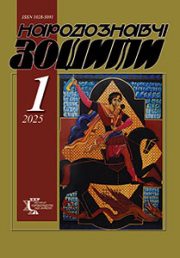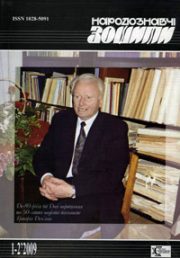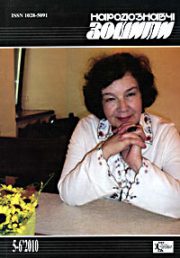The Ethnology Notebooks. 2019, № 6 (150), 1700—1707
UDK7:339.166.5:347.78
DOI https://doi.org/10.15407/nz2019.06.1700
ART WORK AS A DIMENSION OF A MONETARY EQUIVALENT
HAVRYSHKEVYCH Ihor
ORCID ID: https://orcid.org/0000-0002-4074-5248
People’s Artist of Ukraine,
Honored Artist of Ukraine,
member of the National Union of Artists of Ukraine,
Associate Professor of Academic Painting
Lviv National Academy of Arts
38 Kubiyovycha Str., 79011 Lviv, Ukraine
Abstract. Formulation of the problem. The phenomenon of the art market raises questions about the value of an art work and allows to study the mechanism of interaction between the world of money and the world of art. There is a certain similarity between the system of money and the system of art: both systems are symbolic, their value is the result of a public contract, in the meaning of a social construction, not something inherently by definition. In both cases, the institution — the bank or the museum (gallery) — is the guarantor of value, thus confirming or denying their importance and legitimacy. So, exchanging money for art we exchange one abstraction for another, confirming the absolute conditionality of the weight of one to another.
Actuality. The art market is not only a mechanism for buying and selling art works, but also a space where economics, art, sociology, and philosophy meet. It should be noted that nowadays there are almost no comprehensive studies on the problems of the development and functioning of art market. It is a phenomenon that gives rise to the reflections on the value of an art work, which allows us to look at the specific relationship between the world of money and the art world, to understand the reasons why collectors consider it necessary to buy art works, and artists — to embody alternative ways of interacting with the market. As a result, the issue of identifying a specific mechanism in the artistic field becomes relevant, and it can lead to an increase in the monetary equivalent.
The purpose of this article is not only to identify the category of art works that can be attributed to a profitable monetary equivalent. It aims also to identify certain signs of the pinnacle of creativity in the field of art. The task is to find out what features of the work and under which circumstances can turn it into monetary equivalent, as well as to find out which art works have such a potential.
The methodological background is the economic and cultural approach, which raises the question of the relation between the aesthetic value and the economic value of the art works. Among the scientific methods it is worth mentioning a comparative historical method, partly a method of analysis, synthesis and modeling.
The result of the study was the identifying of a specific mechanism in the artistic field, which leads to an increase in the monetary equivalent of an art work. An attempt to identify the ways of formation and scope of monetary equivalent, as well as to answer the question whether it is profitable to save the capital in the form of the artworks was made
Keywords: artwork, monetary equivalent, art market, masterpiece, capital.
Received 4.12.2019
REFERENCES
Rikardo, D. (2007). Principles of Political Economy and Taxation: favorites. Moskva [in Russian].
Smіt, A. (2018). Wealth of nations. The study of the nature and causes of the welfare of nations. Kyiv: Nash Format [in Ukrainian].
Arutyunova, A.G. (2015). The art market in the XXI century: the space of art experiment. Moskva: Izd. dom Vysshej shkoly ekonomiki [in Russian].
Zagraevskij, S. Ratings of artists: history and modernity. Rating artunion. Retrieved from: http://rating.artunion.ru/article37.htm (Last accessed: 19.06.2019).
Grojs, B. (1991). Apology of the market. Dekorativnoe iskusstvo SSSR, 2, 1—15 [in Russian].
Arnol’d, D. (2018). Speaks and shows the art. What combines the masterpieces of the Paleolithic, Renaissance and performances. Moskva: Mann, Ivanov i Ferber [in Russian].
Pankkherst, E., & Hoksli, L. (2015). Art. Why is this a masterpiece: 80 stories of great works. Sindbad [in Russian].
Dossi P. (2011). Sold! Art and money. Sankt-Peterburg: Limbus Press; Izdatel’stvo K. Tublina [in Russian].
Benamu-YUe, ZH. (2008). The price of art. Moskva: Artmedia grup [in Russian].
The art market: questions of the theory, history, methodology. (2004). Sankt-Peterburg: SPbGUP [in Russian].
Research And Consulting. Arts Economics. Retrieved from: http://artseconomics.com/#research (Last accessed: 19.06.2019).
Gel’man, M. Museums: image, market, power. Art-Azbuka: Retrieved from: http://azbuka.gif.ru/important/guelman-museums-obraz/ (Last accessed: 17.06.2019).
Vollar, A. (2008). Memoirs of the dealer in paintings: the author’s book. Moskva: Izdatel’skij Dom Meshcheryakova [in Russian].
Gapper, J. (2015, 13 may). Picasso is not just a valuable abstract. Financial Times. Retrieved from: https://www.ft.com/content/b4ea7a1a-f955-11e4-ae65-00144feab7de (Last accessed: 19.06.2019).
Bodrijyar, ZH. (2003). Toward a criticism of the political economy of the sign. Moskva: Biblion-Russkaya kniga [in Russian].
Najdorf, M.I. (2009). After the crisis: towards the results of the institutional crisis of the arts in the 20th century. Odessa: B.I. [in Russian].
Lysakova, A.A. (2011). Contemporary art as a commodity in the system of the modern art market. Zhurnal sociologii i social’noj antropologii, 5 (Vol. 14, pp. 230—240) [in Russian].
Liotar, ZH.-F. (1998). The postmodern condition. Moskva, Sankt-Peterburg: Aletejya [in Russian].
Smith, R. (2019, 18 may). Stop Hating Jeff Koons. The New York Times. Retrieved from: https://www.nytimes.com/2019/05/17/arts/jeff-koons-auction-christies.html?action=click&module=MoreInSection&pgtype=Article®ion=Footer&contentCollection=Art%20&%20Design (Last accessed: 19.06.2019).
Melnyk, Yu. (2013). Price bubbles in the global art market. Innovative processes of economic and socio-cultural development: Domestic and foreign experience: materials of the VI International Conference of Young Scientists and Students (Pp. 17—19). Ternopil: TNEU [in Ukrainian].
Rustemova, A. (2005). London galleries exhibit trash. Utro. Retrieved from: http://www.utro.ru/articles/2005/04/11/427337.shtml (Last accessed: 19.06.2019).
Kantor, M. (2009). Sellers of vacuum. Art market. Retrieved from: http://rupo.ru/m/1586/prodawtsy_wakuuma.html (Last accessed: 19.06.2019).
Voloshina, YU. 8 signs of a masterpiece. In-Art. Retrieved from: http://be-inart.com/post/view/916 (Last accessed: 19.06.2019).







